p.43
p.54
p.60
p.67
p.74
p.80
p.85
p.93
p.98
Effect of Solvent Used in the Preparation of Aluminum-Doped ZnO as Electron Acceptor Layer on the Characteristic of its Hybrid Solar Cell
Abstract:
Aluminum doped Zinc Oxide (AZO) layer has been employed as electron acceptor in hybrid solar cell based on Poly(3-hexylthiophene) with inverted structure. AZO layers used in this work were prepared by sol-gel process using two different solvents, namely methanol and methoxyethanol. From X-ray diffraction measurements, AZO layer prepared using methanol solvent (AZO-me) indicates the formation of crystallines with the same (002) orientation, whereas AZO layer prepared using methoxyethanol (AZO-mx) indicates the formation of crystallines with (100), (002), and (101) orientations. The nanomorphology of those AZO layer surfaces was also remarkably different, which might be related to differences in crystal orientation. For both solvents, the photocurrent density-voltage (J-V) characteristics were also affected by the Al ion concentration in AZO layer. However, solar cell with AZO-mx shows better performances in comparison to that of AZO-me with the same Al ion concentration. The observation of performance variations in those fabricated solar cells are suggested to be strongly related with the crystal orientation and nanomorphology of AZO layer. These experimental results then suggest that charge carrier dissociation by AZO layer are significantly influenced by the crystal orientation and nanomorphology of AZO layer, which are affected by the solvent used for preparing the AZO layer.
Info:
Periodical:
Pages:
74-79
Citation:
Online since:
January 2013
Authors:
Price:
Сopyright:
© 2013 Trans Tech Publications Ltd. All Rights Reserved
Share:
Citation:



